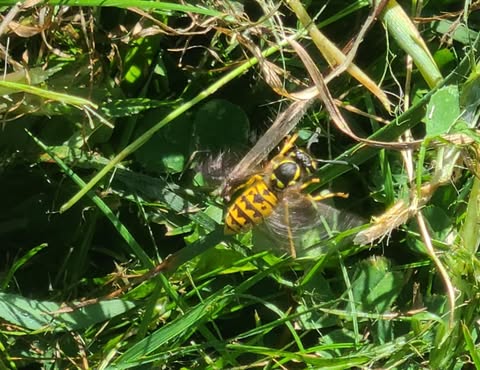There are more yellowjackets out this time of year than previously, according to the Connecticut Agricultural Experiment Station.
As temperatures rise, wasps are better able to survive over the winter months. The average temperature for 2024 was above the average annual temperature of approximately 50 degrees Fahrenheit. Last year, 23 days saw temperatures greater than 90 degrees Fahrenheit. The number of days with high temperatures in 2024 was 52% greater than the average from 1960 to present, according to data.
“There’s a higher density of nests this year that’s a result of milder temperatures, even though we had cold weather, it wasn’t prolonged,” said Dr. Gale Ridge, entomologist with the CAES. “What we’re seeing is young queen wasps surviving through the winter months and the result is more of them were successful at establishing nests this year. So we’re seeing an increase in yellowjackets.”
While the familiar yellow and black insects may sometimes be mistaken for bees, they are actually predatory wasps, according to Ridge.
In Connecticut, there are 16 different species with the most common being the German yellowjacket, Eastern yellowjacket, and Aerial yellowjacket. German yellowjackets most often will enter buildings and try to get into structures, making interactions with humans more likely, Ridge said. Aerial yellowjackets build large nests high up in tree branches.
“We’re also seeing the Southern yellowjacket now trying to establish itself along the northern Connecticut border,” Ridge said. “They are native to the southeast but are an indicator that our winters have gotten more mild since they can survive here. It’s another insect indicator showing how climate change is impacting the movement of these populations around the country.”
Southern yellowjackets are considered more aggressive, larger wasps, which differ from other species by potentially having multiple queens and larger nests, Ridge said.
They are a concern due to their more aggressive nature. However, the species also is a known predator to the highly invasive spotted lanternfly, making it an important insect for controlling invasive populations, she said.
According to Naturalist.com, most southern yellowjackets also are parasitic, as they “benefit at the expense of another species, as seen in their nest formation, as they build their nests around those of another species. Only about 15% of the nests are independently founded.”
Ridge said that yellowjackets use scent as its primary source for finding food and detecting threats. Yellowjackets have a keen sense of smell and are particularly attracted to sugary and protein-rich foods. She said to always store food in sealed containers. This applies particularly to pet food, which can be a significant attractant if left out.
But while yellowjackets can be considered a pest if too close to a property, Ridge said they play an important part in the ecosystem. Yellowjackets are important as predators of garden pests, such as caterpillars and flies, and as scavengers, helping to clean up decaying material. Because of this, they play a vital role in controlling insect populations and supporting biodiversity. Studies have shown that one yellowjacket colony can eat over 200 flies per hour, according to the CAES.
“If you see a nest that’s up in a tree and not close to your house, leave it alone,” Ridge said. “It’s kind of like free pest control.”
Stings from yellowjackets can be painful and deadly if allergic to their venom, Ridge said.
Unlike honeybee stings, wasps can sting multiple times, as their stingers are smooth and not barbed. Ridge said that anyone who has an allergy should carry an EpiPen at all times. Nests that need to be removed should only be sprayed at night as the wasps are less active and more dormant. Yellowjackets cannot see in the dark, making that time ideal to spray and remove a nest.
“Venom is very difficult to make, most animals don’t produce a lot of it. Because of this, wasps, like spiders, generally don’t empty their venom tanks,” Ridge said. “They will hold back and that’s why you will have multiple stinging events. Because they don’t often empty their entire venom in just one sting.
“Generally the smaller yellowjackets tend to be more fierce than larger ones. Yellowjackets are not aggressive when foraging but can get aggressive when you get too close to their nest. It is important to exercise caution around a nest,” she said.
NASA reports, citing the American College of Allergy, Asthma and Immunology, that about 5% of people are allergic to stinging insects.
Suggestions on how to avoid attracting yellowjackets and being stung include:
- Keep garbage cans covered with tight-fitting lids.
- Keep garbage cans away from picnic and meeting places.
- Wash garbage cans regularly.
- Keep food covered if not being eaten.
- Serve sweet and other drinks in covered cups with straws.
- Clear away food items after a meal immediately.
- Eliminate water sources such as birdbaths and dripping faucets.
- Avoid going barefoot.
- Remain calm when a wasp lands on you. Don’t swat the insect. Yellowjackets rarely sting if they are left alone.
- Check your food and beverage for yellowjackets before you eat and drink.
- Avoid wearing hairsprays, perfumes, colognes, suntan lotion or brightly colored clothes outdoors.
- Exercise care while working around leaf litter at margins of the yard. Nests are sometimes built nearby under the leaves.
- Mow carefully. Be observant ahead of the mower in case there is a nest in the lawn.
Stephen Underwood can be reached at sunderwood@courant.com.
